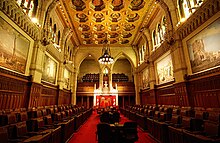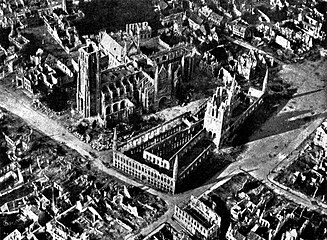Ypres Cloth Hall
| Ypres Cloth Hall | |
|---|---|
Lakenhal or Lakenhalle | |
 Ypres Cloth Hall seen from the Grote Markt | |
| General information | |
| Architectural style | Gothic |
| Location | Ypres, West Flanders |
| Country | Belgium |
| Coordinates | 50°51′04″N 2°53′09″E / 50.8512°N 2.8858°E |
| Construction started | 13th century |
| Estimated completion | 1304 |
| Renovated | 1933–1967 |
| Height | 70 m (230 ft) |
| Design and construction | |
| Architect(s) | Jules Coomans and P. A. Pauwels |
| Other information | |
| Parking | On site |
| Website | |
| trabel.com/ieper-clothhall (archived 13 May 2006) | |
The Cloth Hall (
The hall lay in ruins after artillery fire devastated Ypres in
History
Medieval structure
The original Cloth Hall was built between about 1200 and 1304.
Destruction and rebuilding
The Cloth Hall was almost completely destroyed during the First World War and rebuilt after the conflict.[5] After long debates animated by quarrels between amateurs and experts, the architects, including Jules Coomans, opted for a faithful and rigorous restitution of the building based on surveys carried out before and during the war. The reconstruction of St. Martin's Cathedral, located at the rear, had just been completed when the Cloth Hall's reconstruction began. The current hall is therefore largely an exact replica of the medieval building as it existed before the war. However, some parts of the monument are still original, notably in the western part and at the base of the belfry. Most of the reusable old elements found in the ruins and the rubble were reintegrated into the monument, and they served as a model for the missing elements. Reconstruction work ended in 1967.
-
The Cloth Hall c. 1860, showing the original medieval building before World War I
-
Aerial view during the war. The destruction is not over at this point.
-
The ruined city centre with the hall and the cathedral at the end of the war
Building

In a row spanning the front of the edifice are tall pointed arches that alternately enclose windows and
The belfry, capped with four turrets and a spire, houses a carillon with 49 bells. From a pole atop the spire a gilded dragon overlooks the city. The tower offers an expansive view of the surroundings, and was used as a watchtower in centuries past. It has also accommodated the town archives, a treasury, an armory and a prison. In less enlightened times, cats were thrown off the belfry for reasons that are not clearly understood. One theory is that cats were in some way associated with black magic. A different theory is that cats were held to protect the cloth against mice, but the annual excess of kittens had to be dealt with in some way. Today, a jester commemorates this act by tossing stuffed toy felines from the tower during the triennial Cat Parade.
The Cloth Hall used to be accessible by boat via the Ieperlee waterway, which is now covered. The spacious ground-floor halls where wool and cloth were once sold are now used for exhibitions and tourist information; the second floor, formerly a warehouse, now hosts the In Flanders Fields Museum, dedicated to the history of the Great War and also houses a World War I research centre. Via the museum, visitors can access the belfry tower.
Against the east face of the edifice stands the elegant Nieuwerck, whose Renaissance style contrasts markedly with the Gothic of the main building. Originally built between 1619 and 1622, and reconstructed after the war, this annex now serves as a town hall.
International significance

A painting of the Cloth Hall as it appeared in ruins in 1918, by Scottish-born artist James Kerr-Lawson, was one of over 1,000 pieces of art commissioned by the Canadian War Memorials Fund for part of a World War I memorial building that was planned after the war. However, the memorial building was eventually scrapped in favour of a memorial cenotaph at the centre of Confederation Square, across the street from Parliament Hill in Ottawa. The painting of the Cloth Hall, and seven other of the commissioned pieces, were instead hung in the Senate Chamber of the newly re-built Centre Block of parliament in 1921, and remains there today.[6]
The design of the
See also
- Delaware and Hudson Railway Building, a 20th-century copy of the Cloth Hall in Albany, New York, United States
- List of carillons in Belgium
References
- ^ "Cloth Hall (Ypres, Begium)". Cloth Hall (Ypres, Begium) | Items | National Library of New Zealand | National Library of New Zealand. Retrieved 2022-04-26.
- ^ "Belfries of Belgium and France". UNESCO World Heritage Centre. United Nations Educational, Scientific, and Cultural Organization. Retrieved 5 November 2021.
- ^ Rolf Falter, België: Een geschiedenis zonder land (in Dutch), (Antwerp: De Bezige Bij, 2012), p. 85.
- ^ Guide d'architecture de la métropole lilloise (Lille Métropole-Courtrai-Tournai-Ypres) (in French), éditions Le Passage, 2009, (ISBN 978-2-84742-128-6), p. 92–93
- ^ A. Bras and J. Cornillie, Geschiedenis van de Lakenhalle te Ieper vanaf den opbouw tot onder den wereldoorlog (in Dutch), (Ypres: s.d., 1930)
- ^ Library of Parliament (May 2007). "The War Paintings in the Senate Chamber". Library of Parliament. Retrieved 7 August 2012.
- ISBN 978 0 7188 9548 8.
External links
- Ypres: The Cloth Hall from Trabel.com
- (in Dutch) Description and picture gallery from Belgiumview
- In Flanders Fields Museum




